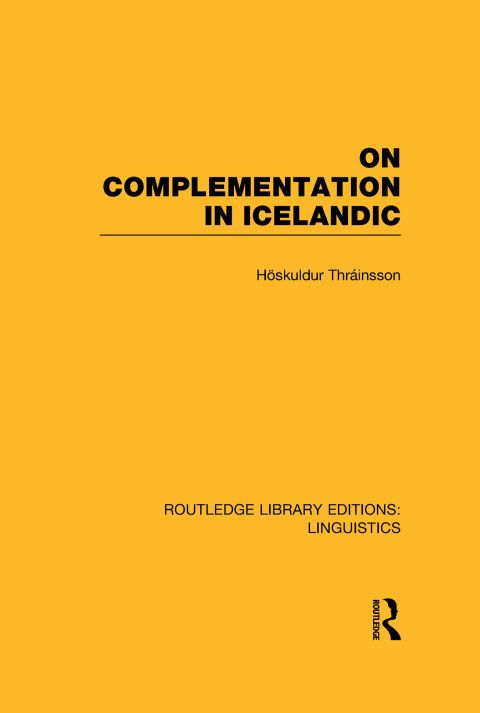Description
Efnisyfirlit
- Cover Page
- Half Title Page
- Title Page
- Copyright Page
- Original Title Page
- Original Copyright Page
- On Complementation in Icelandic
- Acknowledgements
- Contents
- Introduction
- Footnotes to the Introduction
- Part I To Be or not To Be an NP An Overview of Icelandic Complement Structures
- Introduction
- Footnotes to the Introduction
- Chapter 1 Phrase Structure Evidence
- 1.0 The form of the argument
- 1.1 Intransitive, transitive and ditransitive verbs
- 1.1.1
- 1.1.2
- 1.1.3
- 1.2 Prepositional complements and particle verbs
- 1.3 Clauses in subject position
- 1.4 Strict subcategorization and selectional restrictions
- 1.4.0
- 1.4.1
- 1.4.2
- 1.5 Conclusion
- Footnotes to Chapter 1
- Chapter 2 Transformational Evidence
- 2.0 The form of the argument
- 2.1 Some frequently cited NP-rules and their discourse function
- 2.1.0
- 2.1.1 Topicalization, Left Dislocation, and Contrastive Dislocation
- 2.1.1.0
- 2.1.1.1
- 2.1.1.2
- 2.1.1.3
- 2.1.1.4
- 2.1.2 Right Dislocation and Extraposition
- 2.1.2.0
- 2.1.2.1
- 2.1.3 Clefts and Relatives
- 2.1.3.0
- 2.1.3.1
- 2.1.3.2
- 2.1.3.3
- 2.1.4 Passive
- 2.2 Matching rules
- 2.2.0
- 2.2.1 Conjunction
- 2.2.2 Gapping
- 2.3 Constraints on the position of NP clauses
- 2.3.0
- 2.3.1
- 2.3.2
- 2.3.3
- 2.3.4
- 2.3.5
- 2.4 Special constraints on infinitival clauses
- 2.4.0
- 2.4.1
- 2.4.2
- 2.4.3
- 2.4.4
- 2.4.5
- 2.5 Conclusion of Part I
- Footnotes to Chapter 2
- Part II Complement Types and Complement Rules
- Introduction
- Chapter 3 Selection of Complement Clause Types
- 3.0 Introduction
- 3.1 Background
- 3.2 A suggestion and some evidence from Icelandic
- 3.2.0
- 3.2.1
- 3.2.2
- 3.2.3
- 3.3 Conclusion
- Footnotes to Chapter 3
- Chapter 4 Extraposition
- 4.0 Introduction
- 4.1 Rule or no rule?
- 4.1.0
- 4.1.1
- 4.1.2
- 4.1.3
- 4.1.4.
- 4.2 Extraposition vs. Intraposition
- 4.2.0
- 4.2.1
- 4.2.2
- 4.2.3
- 4.2.3.1
- 4.2.3.2
- 4.2.4
- 4.2.4.0
- 4.2.4.1
- 4.2.4.2
- 4.2.4.3
- 4.2.4.4
- 4.2.5
- 4.3 What is ‘it’?
- 4.3.0
- 4.3.1
- 4.3.2
- 4.3.3
- 4.3.3.0
- 4.3.3.1
- 4.3.3.2
- 4.3.3.3
- 4.3.3.4
- 4.3.4
- 4.3.4.0
- 4.3.4.1
- 4.3.4.2
- 4.3.4.3
- 4.3.5
- 4.3.5.0
- 4.3.5.1
- 4.3.5.2
- 4.3.5.3
- 4.3.5.4
- 4.3.6
- 4.3.6.0
- 4.3.6.1
- 4.3.6.2
- 4.3.7
- 4.4 Object Extraposition
- 4.4.0
- 4.4.1 Verb classes and Object Extraposition
- 4.4.1.1
- 4.4.1.2
- 4.4.1.3
- 4.4.2 What is ‘it’?
- 4.4.2.0
- 4.4.2.1
- 4.4.2.2
- 4.4.2.3
- 4.4.2.4
- 4.4.2.5
- 4.4.3 We also need [NPS] objects
- 4.4.3.1
- 4.4.3.2
- 4.4.3.3
- 4.4.3.4
- 4.4.4 Towards an explanation and a formulation
- 4.4.4.1
- 4.4.4.2
- 4.4.4.3
- 4.4.4.4
- 4.5 Summary and residual problems
- 4.5.1
- 4.5.2
- 4.5.3
- 4.5.4
- Footnotes to Chapter 4
- Chapter 5 Equi and Infinitival Complements
- 5.0 Introduction
- 5.1 Clause or not a clause
- 5.1.0 Introductory notes
- 5.1.1 Some general considerations
- 5.1.2 Transitivity
- 5.1.3 Passive and Subject Raising
- 5.1.4 Reflexivization
- 5.1.5 Reciprocals
- 5.1.6 Agreement
- 5.1.7 Adverbial modification
- 5.1.8 Conclusion
- 5.2 The nature of the subject rule
- 5.2.0
- 5.2.1 Could Equi be a transformation?
- 5.2.2 Could the subject be non-lexical?
- 5.2.3 The like-subject constraint and idiosyncrasies
- 5.3 Conclusion
- Footnotes to Chapter 5
- Chapter 6 Subject Raising
- 6.0 Introduction
- 6.1 A clausal analysis or a VP analysis?
- 6.1.1 If not syntax then semantics
- 6.1.1.0
- 6.1.1.1 Selectional restrictions
- 6.1.1.2 Reflexives
- 6.1.1.3 Reciprocals
- 6.1.1.4 Pronominalization possibilities
- 6.1.1.5 Adverbial modification
- 6.1.2 Syntax rather than semantics
- 6.1.2.0
- 6.1.2.1 Að-marking
- 6.1.2.2 Transitivity and case marking
- 6.1.2.3 Non-nominative subjects (?)
- 6.1.2.4 Extraposition
- 6.1.2.5 Idiom chunks and dummy subjects
- 6.1.2.6 Passive
- 6.1.2.7 Agreement
- 6.1.3 Conclusion
- 6.2 Raising or tenseless S ?
- 6.2.0 Introduction
- 6.2.1 Constituenthood
- 6.2.1.0
- 6.2.1.1 Right Node Raising
- 6.2.1.2 Gapping
- 6.2.1.3 Various other constructions
- 6.2.2 Clause boundary location and grammatical relations
- 6.2.2.0
- 6.2.2.1 Case marking
- 6.2.2.2 Passive
- 6.2.2.3 Topicalization
- 6.2.2.4 Adverbial modifiers
- 6.2.3 Some psycholinguistic evidence
- 6.2.3.0
- 6.2.3.1 Method
- 6.2.3.2 Subjects and procedure
- 6.2.3.3 The boundary effect
- 6.2.3.4 Object Equi vs. ACI complements
- 6.2.3.5 Conclusion
- 6.2.4 Is there a rule of SOR?
- 6.3 Subject-to-subject raising
- 6.3.0 Introduction
- 6.3.1 Why assume SSR?
- 6.3.2 The situation in Icelandic
- 6.3.3 Some problems
- 6.3.4 Bresnan’s alternative
- 6.3.5 Pros and cons
- 6.3.5.1 Problems with Bresnan’s arguments and assumptions
- 6.3.5.2 Advantages of the empty subject analysis
- 6.3.6 Predicative complements?
- 6.3.7 Relation to passives?
- 6.3.8 Subject-to-predicative raising?
- 6.3.9 Some suggestions for further study
- 6.4 Some implications of Raising
- 6.4.1 Idiosyncrasies
- 6.4.2 Why semantic classes?
- 6.4.3 What must the raising rules do?
- 6.4.4 The general picture
- Footnotes to Chapter 6
- Part III Some Implications and Suggestions
- Introduction
- Chapter 7 Impersonal Constructions
- 7.1 Impersonal constructions without dummies
- 7.1.0
- 7.1.1
- 7.1.1.0
- 7.1.1.1
- 7.1.1.2
- 7.1.1.3
- 7.1.1.4
- 7.1.1.5
- 7.1.1.6
- 7.1.1.7
- 7.1.1.8
- 7.1.1.9
- 7.2 Impersonal constructions with dummies
- 7.2.0
- 7.2.1.
- 7.2.2
- 7.2.3
- Footnotes to Chapter 7
- Conclusion
- Appendix A
- 6.2.3.3
- 6.2.3.4
- Appendix B
- References






Reviews
There are no reviews yet.